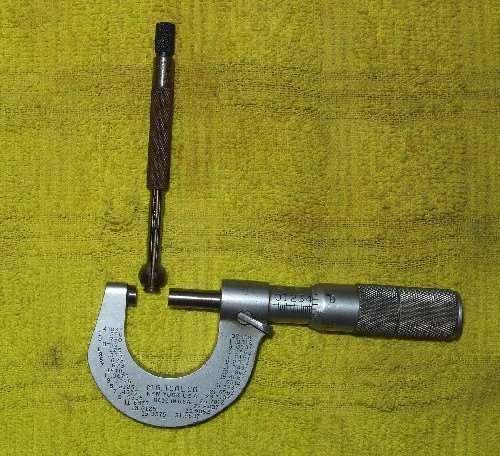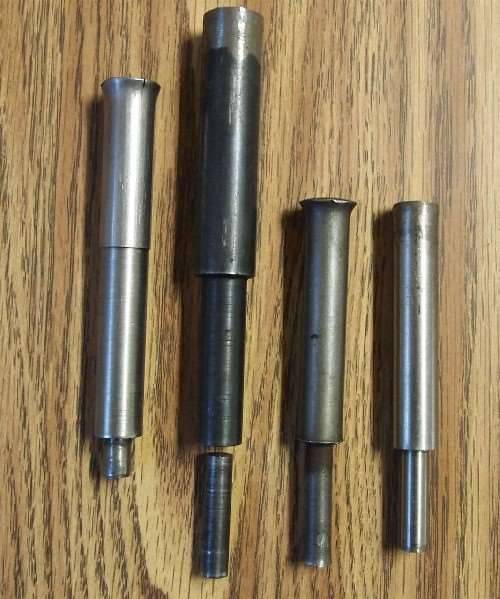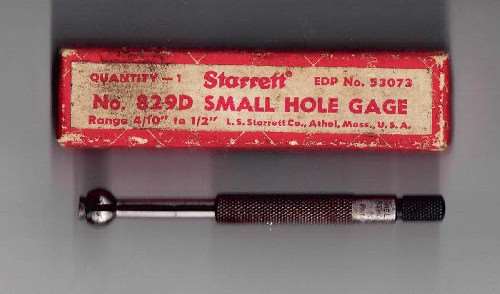Re: Cylinder and piston wear
Posted by Owen_Dyneto On 2014/10/1 17:49:22
The crack is characteristic of those caused by freezing, i.e. lack of sufficient antifreeze.
You can measure the valve guides with a split-ball type of bore gauge which is then measured with a micrometer - I'll give a picture of one, also recognize the wear can be bell-shaped, more at the extremes than the center. You can also get an approximation of guide wear by inserting a NEW valve (thus no stem wear) and rocking it back and forth against a dial indicator. Exhaust valve guides have a tough environment to live in, I'd replace any that are even slightly suspect. Valve guides are driven in with a valve guide driver, KD-815 (2nd from left, with broken tip) is NLA, also shown are some others that I've made and used. You can have one turned from mild steel - the small bore that fits inside the guide should be 11/32nds and the first step MUST be smaller than the OD of the guide. Hammer should probably be a 4#.
Chilling new guides in dry ice make installation a snap. If the lifters are still in place, remove the old ones by driving down part way and then snapping them off with a cold chisel (much easier than it sounds, they are very brittle) and then continue driving the remainder down and out. As best I can tell from your photo the seats look pretty good and nice and narrow, if they are all like that, just a hand-lapping with valve grinding compound should do the trick.
This might be a useful primer for you:http://www.packardclub.org/forum/viewtopic.php?f=14&t=862
Note the Starrett gauge pictured is NOT the correct size for Packard valve guide measurement.
Attach file:
 (233.63 KB)
(233.63 KB)

 (144.63 KB)
(144.63 KB)

 (100.78 KB)
(100.78 KB)

You can measure the valve guides with a split-ball type of bore gauge which is then measured with a micrometer - I'll give a picture of one, also recognize the wear can be bell-shaped, more at the extremes than the center. You can also get an approximation of guide wear by inserting a NEW valve (thus no stem wear) and rocking it back and forth against a dial indicator. Exhaust valve guides have a tough environment to live in, I'd replace any that are even slightly suspect. Valve guides are driven in with a valve guide driver, KD-815 (2nd from left, with broken tip) is NLA, also shown are some others that I've made and used. You can have one turned from mild steel - the small bore that fits inside the guide should be 11/32nds and the first step MUST be smaller than the OD of the guide. Hammer should probably be a 4#.
Chilling new guides in dry ice make installation a snap. If the lifters are still in place, remove the old ones by driving down part way and then snapping them off with a cold chisel (much easier than it sounds, they are very brittle) and then continue driving the remainder down and out. As best I can tell from your photo the seats look pretty good and nice and narrow, if they are all like that, just a hand-lapping with valve grinding compound should do the trick.
This might be a useful primer for you:http://www.packardclub.org/forum/viewtopic.php?f=14&t=862
Note the Starrett gauge pictured is NOT the correct size for Packard valve guide measurement.
Attach file:
 (233.63 KB)
(233.63 KB)
 (144.63 KB)
(144.63 KB)
 (100.78 KB)
(100.78 KB)
This Post was from: https://packardinfo.com/xoops/html/modules/newbb/viewtopic.php?post_id=150710